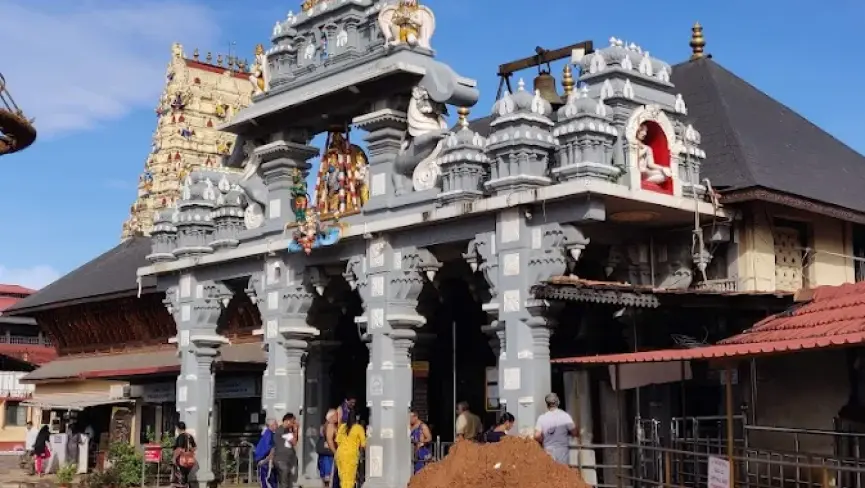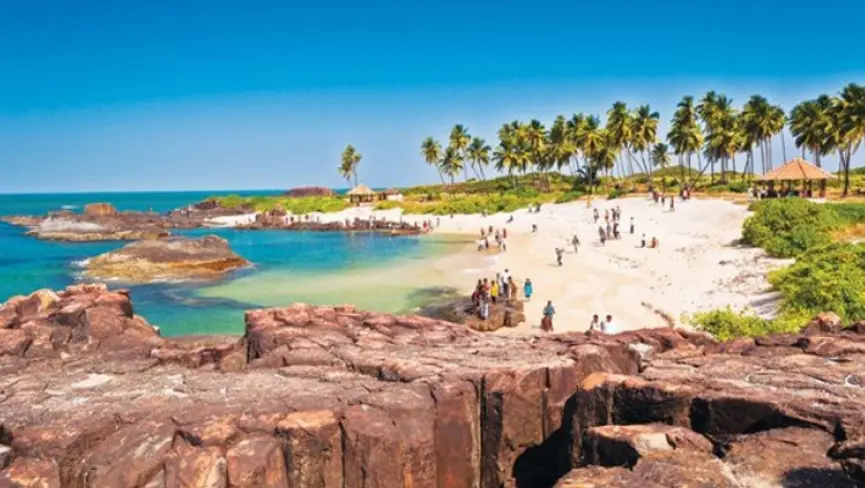
Complete Guide to Visiting Udupi Sri Krishna Temple
The Udupi Sri Krishna Temple in Karnataka is one of the most revered pilgrimage sites in South India. Known for its unique Kanakana Kindi (a special window through which devotees view the deity), the temple attracts thousands of visitors every day. This guide covers its history, significance, darshan timings, dress code, festivals, and travel tips so you can plan a memorable visit.
History of Udupi Sri Krishna Temple
The Udupi Sri Krishna Temple in Karnataka has a history that dates back over 800 years. It is closely associated with Sri Madhvacharya (1238–1317 AD), the great saint, philosopher, and founder of the Dvaita Vedanta school of philosophy.
According to legend, Madhvacharya once rescued a ship caught in a violent storm near the Malpe coast. In gratitude, the ship’s captain offered him gifts. Among them was a large lump of Gopi Chandana (sandalwood paste) which, when broken open, revealed a beautiful idol of Lord Krishna holding a churn and rope (Balakrishna form). This idol is believed to have been originally worshipped by Rukmini Devi in Dwarka during Lord Krishna’s lifetime.
Madhvacharya installed the idol in Udupi in 1238 AD, establishing it as a sacred center for Vaishnavite worship. He placed the idol facing west and introduced a unique tradition — darshan through the Kanakana Kindi, a small silver-plated window. This was inspired by the devotion of Kanakadasa, a saint-poet who was denied entry into the temple but received Lord Krishna’s blessings through this window.
Since then, the temple has been managed under the Ashta Matha system, where eight monasteries founded by Madhvacharya take turns managing temple affairs every two years during the grand Paryaya Festival.
Architectural Highlights of Udupi Sri Krishna Temple
The Udupi Sri Krishna Temple showcases a blend of Dravidian temple architecture and coastal Karnataka’s traditional design. Built primarily from stone and wood, the temple complex is simple yet spiritually captivating, reflecting the humility and devotion central to Vaishnavite traditions.
One of its most unique features is the Kanakana Kindi – a small, silver-plated lattice window through which devotees have darshan of Lord Krishna. Unlike most temples where the deity faces east, the idol here faces west, and darshan is offered through this side window rather than the front entrance.
The sanctum sanctorum (garbhagriha) houses the Balakrishna idol, adorned with jewels and flowers, placed on a beautifully carved wooden pedestal. The outer prakaram (circumambulatory path) is surrounded by shrines dedicated to various deities and saints.
The temple also features a large chariot (ratha) made of wood, intricately carved with scenes from the Mahabharata and Bhagavata Purana, used during the annual Rathotsava. The temple’s inner walls and ceiling beams are decorated with motifs of lotus flowers, divine symbols, and mythological carvings.
A serene temple tank called Madhwa Sarovara lies within the premises, where rituals and daily theertha (holy water) collections take place. The temple’s layout ensures that devotees move in a clockwise direction, passing through different spiritual focal points before reaching the main darshan spot.
Religious Significance of Udupi Sri Krishna Temple
The Udupi Sri Krishna Temple is not just a place of worship but a profound spiritual center for followers of Vaishnavism. Devotees believe that Lord Krishna here manifests in his Balakrishna form — symbolizing innocence, divine love, and protection. This child form of Krishna reminds worshippers to approach God with purity and devotion.
The temple is the heart of the Ashta Matha tradition, established by Sri Madhvacharya, where eight monasteries take turns managing the temple every two years in a sacred rotation called the Paryaya system. This unique arrangement ensures that the temple’s rituals, traditions, and philosophy remain intact for centuries.
One of the most significant aspects of worship at Udupi is the Kanakana Kindi — the small silver-plated window through which darshan is offered. This tradition honors Kanakadasa, the saint-poet whose unshakable devotion moved Lord Krishna to grant him a miraculous vision, even when others denied him entry.
Daily pujas and sevas here are performed with strict adherence to Vedic traditions, including Nirmalya Darshan, Alankara Seva, and Anna Prasada distribution. Thousands of pilgrims visit each day, believing that a sincere prayer to Udupi Krishna brings blessings of health, prosperity, and spiritual fulfillment.
The temple is also considered one of the holiest pilgrimage destinations in South India, often visited alongside Dwarka and Guruvayur, forming an important Krishna worship circuit.
Udupi Sri Krishna Temple Darshan Timings
The Udupi Sri Krishna Temple follows a well-structured daily schedule with multiple darshan sessions, allowing devotees to experience the divine presence of Lord Krishna throughout the day.
Regular Darshan Timings:
-
Nirmalya Darshan (Early Morning): 5:30 AM – 6:00 AM
-
Morning Darshan: 6:00 AM – 9:00 AM
-
Midday Darshan: 11:00 AM – 1:00 PM
-
Evening Darshan: 5:00 PM – 8:50 PM
(Note: Timings may vary during festivals, special poojas, and on important temple occasions.)
Daily Rituals Include:
-
Nirmalya Darshan – Viewing the Lord as he appeared early in the morning before decoration.
-
Panchamrita Abhisheka – Sacred bath with milk, curd, ghee, honey, and sugar.
-
Alankara Seva – Decoration of the idol with flowers and ornaments.
-
Anna Prasada Seva – Free meal offered to devotees in the temple dining hall.
Best Time to Visit:
Early morning darshan is considered highly auspicious, especially during Ekadashi, Krishna Janmashtami, and the Paryaya Festival.
Dress Code & Rules at Udupi Sri Krishna Temple
The Udupi Sri Krishna Temple maintains a traditional dress code to preserve the sanctity and cultural heritage of the temple. Devotees are expected to dress modestly and respectfully before entering the premises.
Dress Code for Men:
-
Traditional attire such as dhoti or mundu is preferred.
-
Shirts and t-shirts are allowed, but they should be simple and not sleeveless.
-
Shorts and lungis are not permitted inside the sanctum area.
Dress Code for Women:
-
Saree, salwar kameez, or other traditional Indian wear is recommended.
-
Avoid short dresses, skirts, or western casuals inside the temple premises.
General Rules for Devotees:
-
Footwear must be removed before entering the temple complex.
-
Photography and videography are strictly prohibited inside the sanctum sanctorum.
-
Maintain silence and discipline in the temple premises.
-
Mobile phones should be on silent mode.
-
Follow queue systems during darshan, especially on festival days.
Major Festivals at Udupi Sri Krishna Temple
Major Festivals at Udupi Sri Krishna Temple
The Udupi Sri Krishna Temple is a vibrant center of devotion, where grand festivals are celebrated with deep spiritual significance and cultural splendor. These events attract thousands of devotees from across India, making Udupi a hub of Krishna worship throughout the year.
1. Krishna Janmashtami
-
When: August/September (Ashtami Tithi of Krishna Paksha in Bhadrapada month)
-
Celebrates the divine birth of Lord Krishna with midnight pujas, special alankaras (decorations), devotional singing, and cultural programs. The temple organizes Rathotsava (chariot procession) and Mosaru Kudike (breaking of curd pots), which are major attractions.
2. Paryaya Festival
-
When: Every two years in January
-
Marks the formal transfer of temple administration from one monastery (matha) to another among the Ashta Mathas. The new pontiff takes charge after a grand procession, Vedic rituals, and celebrations that last several days.
3. Makara Sankranti
-
When: January 14/15
-
Symbolizes the sun’s transition into the zodiac sign of Capricorn. Devotees offer special prayers for prosperity, and the temple sees elaborate floral decorations.
4. Annual Rathotsava (Chariot Festival)
-
When: Usually in February or March
-
The beautifully decorated wooden chariot carrying Lord Krishna’s idol is pulled through the streets by devotees, accompanied by drums, chanting, and bhajans.
5. Deepavali (Diwali)
-
When: October/November
-
The temple is illuminated with thousands of lamps, and special rituals are performed to seek divine blessings for health and wealth.
6. Vaikuntha Ekadashi
-
When: December/January
-
Believed to be the day when the gates of Vaikuntha (Lord Vishnu’s abode) are open. Devotees fast, offer prayers, and participate in night-long bhajans.
How to Reach Udupi Sri Krishna Temple
The Udupi Sri Krishna Temple is located in the heart of Udupi town in Karnataka’s coastal region and is well connected by air, rail, and road. Pilgrims from across India and abroad visit this sacred shrine throughout the year.
By Air
-
Nearest Airport: Mangalore International Airport (IXE) – approximately 60 km away.
-
From the airport, you can hire a taxi or take a direct bus to Udupi (1.5 to 2 hours travel time).
By Train
-
Nearest Railway Station: Udupi Railway Station – about 3 km from the temple.
-
The station is on the Konkan Railway line, with regular trains from Mangalore, Mumbai, Goa, and Kerala.
-
From the station, autos, taxis, and local buses are available to the temple.
By Road
-
Udupi is well connected via NH 66 to Mangalore, Kundapura, Goa, and Mumbai.
-
KSRTC and private buses operate daily services from major cities in Karnataka, Kerala, and Goa.
-
Taxis and auto-rickshaws are available within the city for local travel.


